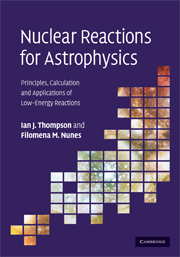Book contents
- Frontmatter
- Contents
- Preface
- Sources of quotations
- Acknowledgements
- 1 Nuclei in the Cosmos
- 2 Reactions of nuclei
- 3 Scattering theory
- 4 Reaction mechanisms
- 5 Connecting structure with reactions
- 6 Solving the equations
- 7 Approximate solutions
- 8 Breakup
- 9 Three-body nuclei
- 10 R-matrix phenomenology
- 11 Compound-nucleus averaging
- 12 Stellar reaction rates and networks
- 13 Connection to experiments
- 14 Spectroscopy
- 15 Fitting data
- Appendix A Symbols
- Appendix B Getting started with Fresco
- Select bibliography
- Index
2 - Reactions of nuclei
Published online by Cambridge University Press: 05 March 2012
- Frontmatter
- Contents
- Preface
- Sources of quotations
- Acknowledgements
- 1 Nuclei in the Cosmos
- 2 Reactions of nuclei
- 3 Scattering theory
- 4 Reaction mechanisms
- 5 Connecting structure with reactions
- 6 Solving the equations
- 7 Approximate solutions
- 8 Breakup
- 9 Three-body nuclei
- 10 R-matrix phenomenology
- 11 Compound-nucleus averaging
- 12 Stellar reaction rates and networks
- 13 Connection to experiments
- 14 Spectroscopy
- 15 Fitting data
- Appendix A Symbols
- Appendix B Getting started with Fresco
- Select bibliography
- Index
Summary
I was taught that the way of progress was neither swift nor easy.
Marie CurieIn order to understand nuclear reactions, we have first in Section 2.1 to name the arrangement of nucleons in a nucleus in terms of the quantum-mechanical state of a nucleus, and then describe the different ways in which these nucleons may be rearranged during nuclear reactions. Reactions which proceed quickly, and thus called direct reactions, are distinguished in Section 2.2 from the comparatively slow reactions that also occur, which are called compound nucleus reactions. Almost all reactions involve the collision of two nuclei, and Section 2.3 shows how the conservations of mass, energy and momentum may be described in either non-relativistic or relativistic kinematics. Section 2.4 describes how the rates of nuclear reactions are measured in terms of cross sections, which have units of area. We show how these cross sections are different in the laboratory and center of- mass coordinate frames of reference, then in the final subsection 2.4.4 how the cross sections may be determined from the wave functions that are solutions of a Schrödinger equation for the pair of reacting nuclei.
Kinds of states and reactions
States of nuclei
Nuclei are aggregations of Z protons and N neutrons in a particular configuration or state described by a wave function φ determined from quantum mechanics, given the strong and electromagnetic potentials V between the A=N + Z constituent nucleons. A state is called bound if energy is needed to remove one or more nucleons to large distances.
- Type
- Chapter
- Information
- Nuclear Reactions for AstrophysicsPrinciples, Calculation and Applications of Low-Energy Reactions, pp. 28 - 47Publisher: Cambridge University PressPrint publication year: 2009



